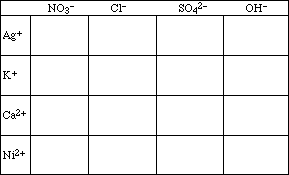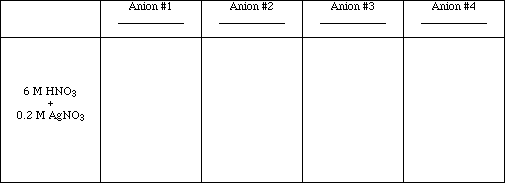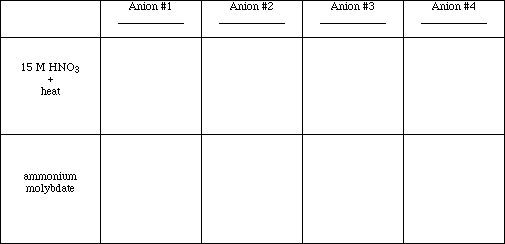![]() Pre-lab Questions
Pre-lab Questions
![]() Experiment
Experiment
![]() Post-lab Questions
Post-lab Questions
EXPERIMENT 15: ANION ANALYSIS
The following preparatory questions should be answered before coming to class. They are intended to introduce you to several ideas important to aspects of the experiment. You must turn-in your work to your instructor before you will be allowed to begin the experiment. Be sure to bring a calculator and paper to laboratory.
1. Read the sections in your text concerning solubility rules.
![]()
2. Using the solubility information in your text, complete the following table. (Simply enter soluble (S)
or insoluble (I) in each compartment.)

3. Write net ionic equations for those combinations that produce insoluble products.
![]()
![]()
4. Diagram a scheme to separate a mixture containing Ag+, Ca2+ and Ni2+.
![]()
![]()
EXPERIMENT 15: ANION ANALYSIS
![]() Top
Top
EQUIPMENT:

INTRODUCTION :
It is VERY important that you take care to prevent contamination because of the large number of experiments that will be performed in this experiment. Be sure to use deionized water in all chemical tests. Even the smallest amount of contamination can cause changes the results of your tests. This will lead you to record incorrect observations and to make wrong conclusions. As you are performing these experiments individually, you will have no one but yourself to blame for such errors. Following every test you should carefully clean the equipment with deionized water. Cleaning your test tubes and droppers following an experiment can prevent contamination on a subsequent experiment. You should take care to label the vials which contain important stock solutions. Labels should be available in the laboratory. When testing how the anions behave to a specific reagent, perform tests on all ions simultaneously. Be sure that test tubes and/or the locations of the test tubes in the test tube rack are clearly labeled. Record observations immediately after each test. Following the test of all anions, check each test tube a second time to strengthen your observations.
When writing your observations be sure to note colors of precipitates and supernatant solutions and precipitate texture. Are gases formed? Are reactions exothermic, endothermic, or is it difficult to tell? Remember, 'no reaction' is an important observation. Some combinations of reagents do not react.
All observed reactions must include the correct equations. Your instructor can help - so ask.
![]()
![]()
Part I: Qualitative Analysis of Anions
Obtain 1 mL samples of 0.5 M solutions of the salts NaCl, KI, Na3PO4, and Na2SO4 in separate, clean, labeled vials/test tubes. Dilute each solution to a final volume of 5 mL using deionized water.2
These will be your 'Test Solutions'. Identify the formulas and charges for the anions on the line below and have your instructor check them before continuing.
![]()
Each of the anion solutions should be subjected to each of the following tests. Record the anion and your observations following each experiment.
Chemical Tests: All tests should be performed in clean test tubes sized to fit the centrifuge.
Test #1
![]()
To 20 drops of each test solution add 6 M HNO3 (dilute) until the solution is acidic. The acidic
character of the test solution can be detected using blue litmus paper. To test pH: Obtain a drop of the
solution on the end of a glass stirring rod. Touch the wet tip of the rod to a strip of blue litmus paper.
Note the color change. An acidic solution will cause blue litmus paper to turn red. Be sure to check the
test solution with litmus paper before adding the HNO3. If the solution is initially acidic, add one drop of
the acid, then continue.
![]()
Add 15 drops of 0.2 M AgNO3 to each solution. If a precipitates form, centrifuge the test tube
and decant the supernatant liquid. Save any precipitates formed for test #2.
Obs. #1

Write the ionic and net ionic equations for those tests which resulted in chemical reactions.
Rxn. #1
![]()
![]()
Test #2
![]()
If no precipitate formed for an anion in Test #1, draw an X in the appropriate box in Obs. #2. Test
#2 is not performed on anions which did not form a precipitate in Test #1. Wash each precipitate obtained
from test #1 twice using deionized water. (Remember the washing procedure requires adding deionized
water, stirring, so that all of the solid is in contact with the water, centrifuging, and decanting the
supernatant liquid.) Place a small amount of each precipitate in a clean labeled test tube. Add 10 drops of
deionized water and 10 drops of 3 M NH3(aq) to each and mix for several minutes. Centrifuge. Pour
the supernatant liquid into clean test tubes and add 6 M HNO3 (dilute) until each solution is acidic.
Obs. #2

![]()
Write the ionic and net ionic equations for those tests which resulted in chemical reactions.
Rxn. #2
![]()
If you were given an unknown solution which you were told contained either Cl- or I- , both
anions or neither, explain how you would confirm or deny the presence or absence of the ions. (You are
encouraged to perform the experiment in laboratory to test your procedure.)
Expl. #1
![]()
![]()
Test #3
![]()
Add 20 drops of each test solution to a clean dry test tube and use red litmus paper to test if the
solutions are basic. If a solution is basic add 1 drop of 3 M NH3(aq), otherwise add 3 M NH3 (aq)
dropwise until each solution is basic. Add 15 drops of 0.3 M Ba(NO3)2 to each solution. Any
precipitates that formed should be centrifuged. Pour off the supernatant liquid and save all precipitates
for test #4.
Obs. #3

![]()
Write the ionic and net ionic equations for those tests which resulted in chemical reactions.
Rxn. #3
![]()
![]()
Test #4
![]()
If no precipitate formed for an anion in Test #3, draw an X in the appropriate box in Obs. #4. Test
#4 is not performed on anions which did not form a precipitate in Test #3. Wash the precipitates from test
#3 twice with deionized water. Obtain a small amount (do not use all of the precipitate formed!) of each
precipitate in a clean test tube and add 3 mL (~50 drops) of 15 M HNO3 (concentrated), then add 15
drops of deionized water to each and mix. Place the test tubes in a gently boiling water bath for
approximately 5 minutes. Continue to mix the solutions in the test tubes every 30 seconds. Observe and
record what happens during the heating process. To each test tube add 5 drops of 1 M ammonium
molybdate (NH4)(MoO3)4+.
Obs. #4

![]()
Write the ionic and net ionic equations for those tests which resulted in chemical reactions.
Rxn. #4
![]()
![]()
If you were given an unknown solution which you were told contained either PO43- or SO42- , both anions or neither, explain how you would confirm or deny the presence or absence of one or both of these ions. (Because of the difficulty of distinguishing these two ions you should perform the experiment in laboratory to test your procedure.)
![]()
Expl. #2
![]()
![]()
PART II: Separation of a Mixture
Develop an analysis scheme which would allow you to systematically confirm or deny all four of the anions in an unknown solution. As you develop your scheme, assume that someone else will have to follow it when analyzing an unknown. To test your analysis scheme prepare a mixture of the four anions by mixing 1 mL samples of each salt in a clean 13 x 100 test tube. Add 1 mL of deionized water and then use your analysis scheme to separate and identify each anion. Use the space below to write ( or diagram) your analysis scheme and for notes and observations. This should not be a word-for-word copy of the Chemical Tests provided for the first part of this experiment. You should organize the information needed to solve the unknown into a form, such as a flow chart, that is easy to read and simple to follow.
![]()
![]()
PART III: Identification of Anions in an Unknown Mixture
After you have developed and tested your analysis scheme, show it to your instructor. Following his/her evaluation, you will be given an unknown solution. The unknown solution will contain between 0 - 4 anions. After recording the unknown number _______, you are to analyze your unknown and identify the anions present. Additional unknown solution will be available upon request. During the analysis you are to take careful notes of the procedures you follow, recording all tests and observations. After completing your analysis, explain which anions are present and which are absent and how you arrived at these conclusions. The unknown portion of the experiment will count heavily in determining your grade so take your time and be careful.
![]()
![]()
Problems to be turned in with the laboratory write-up.
1. Define clearly the difference between separation and identification.
![]()
2. A sample may contain either, both or neither of the following ions:
CO32- or SO42-. Prepare
a flow chart showing how you would determine the identity of the ions in a solution.
![]()
3. A a clear, colorless solution forms a pale yellow precipitate when KI(aq) is added. The same solution
forms a white precipitate when NaCl(aq) is added. What ion is contained in the solution? Justify your
response.
![]()
4. You are given three unlabeled containers and told that they contain nitric acid, sulfuric acid, and
phosphoric acid. How could you determine which acid is in which container?
![]()
Contents
![]() Return to
Return to![]() Index of Experiments
Index of Experiments